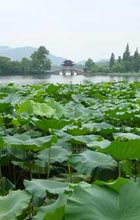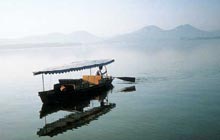
 "Of the thirty-six West Lakes east or west, the West Lake in Hangzhou is the best."
"Of the thirty-six West Lakes east or west, the West Lake in Hangzhou is the best."
As this dictum reveals, China has thirty-six West Lakes – in Beijing, Fuzhou, Guilin, etc. – but none are reputed to be as magnificent as the one in Hangzhou. Originally no more than a shallow inlet, this section of the Qiantong River was dredged and dammed in the eighth century to form the lake that exists today. It was also at this time that the lake's design was enriched with the picturesque north-south Su causeway and the east-west Bai Di causeway.
Fairy Islet, an island at the lake's center, is a wonderful spot to savor its scenic expanse. Amidst this island's intricately designed gardens, ponds and pavilions are the famed "Three Towers Mirroring the Moon". Erected some seven hundred years ago, these so-called towers are actually three small pagoda-like structures placed in the water at a slight distance from the island. Rumoured to control the evil spirits lurking in the water's depths, in mid-August they contain within their hollow structures a reflection of the full moon.
 The east-west Bai Di causeway links the Solitary Island to terra firma. This idyllic retreat has for centuries been a magnet to the rich and famous. It is said that the famous Chinese writer Lin Bu (967-1028) lived in seclusion here for twenty years. Shunning the corrupt life of officialdom, he dedicated himself to the cultivation of the 365 plum blossoms which he planted here. Mundane court life followed in his wake however, when the Qing dynasty Emperor Qianlong (r. 1736-1795), charmed by the island's scenery, established an Imperial Palace on it. But in 1911, in honour of the president of the new republic, the site was opened to the public and renamed Zhongshan Park. (President Sun Yatsen's political name was Sun Zhongshan.) Now the Imperial Palace, incorporated within the Zhejiang Provincial Musuem, is used to display one of China's best ceramic collections.
The east-west Bai Di causeway links the Solitary Island to terra firma. This idyllic retreat has for centuries been a magnet to the rich and famous. It is said that the famous Chinese writer Lin Bu (967-1028) lived in seclusion here for twenty years. Shunning the corrupt life of officialdom, he dedicated himself to the cultivation of the 365 plum blossoms which he planted here. Mundane court life followed in his wake however, when the Qing dynasty Emperor Qianlong (r. 1736-1795), charmed by the island's scenery, established an Imperial Palace on it. But in 1911, in honour of the president of the new republic, the site was opened to the public and renamed Zhongshan Park. (President Sun Yatsen's political name was Sun Zhongshan.) Now the Imperial Palace, incorporated within the Zhejiang Provincial Musuem, is used to display one of China's best ceramic collections.
From a botanical perspective, the best location to enjoy the West Lake is the Quyuan Garden on its western shore. First landscaped during the Southern Song dynasty (1127-1279), it was enlarged into a twenty-eight hectare park in 1978. Within it are over two hundred species of lotus – a view of these unusual flowers blooming (July to September) against the serene background of the West Lake may be one of the most stunning floral spectacles you will ever behold. At other times of the year the garden is still marvelous to visit since tea tables, placed in courtyards and pavilions along the lake shore, create an ideal atmosphere to survey one of the most delightfully picturesuque spots in China.